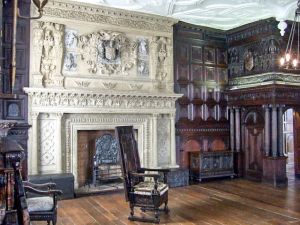
Great Oak Room
Among the best of these features is the beautifully panelled Great Oak Room, with its ornate plasterwork and carved stone fireplace, built by a wealthy merchant named John Young. This is thought to be the last complete Elizabethan room in Bristol.
Craftsmen laboured for two years (1578-80) to complete the room's ornate panelling, plasterwork ceiling and sculpted stone fireplace. The room is shown as it would have looked in the 16th century, with portraits lining the walls and richly decorated furniture.
The original Red Lodge had three main rooms including the Great Oak Room and a bedroom. In the 1730s the Henley family added a three-storey extension that effectively doubled the size of the lodge. The extension included an elegant staircase, New Oak Room, Print Room and the Mary Carpenter Room. It is fascinating to see the contrast between these Georgian rooms and the earlier Great Oak Room.
In 1854 Mary Carpenter helped transform Red Lodge into the first-ever girls' reform school. It must have been an eventful transformation, for Carpenter's diary reveals that on her first visit to look over the Red Lodge she came across a human foot! No such surprises await modern visitors, but you can get a glimpse of what life was like for the girls attending the school, see a school workbook and Mary Carpenter's piano.
Elizabethan Knot Garden
Outside the house is an attractive Elizabethan knot garden, designed so that guests arriving to visit would walk through the garden to reach the house. The garden was restored in the 1980s to show what it would have looked like when the house was built.
The garden is bordered by a wooden trellis in 17th-century style. Inside the trellis, clipped hedges are laid out to replicate the plasterwork design of the ceiling in the master bedroom. The bedroom looks down on the garden.
 We've 'tagged' this attraction information to help you find related historic attractions and learn more about major time periods mentioned.
We've 'tagged' this attraction information to help you find related historic attractions and learn more about major time periods mentioned.


